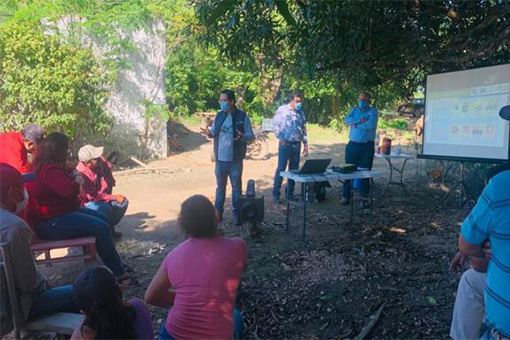Capacity building to reduce Climate Change vulnerability in the Usumacinta River basin (Tabasco, Mexico)
Organization: Espacios Naturales y Desarrollo Sustentable, A.C.
Location: Centla, Jonuta, Macuspana & Tenosique, Tabasco, Mexico
Country: Mexico
Other Organizations Involved: The National Commission of Protected Natural Areas (Conanp), specifically, Conanp’s Coastal Plain and Gulf of Mexico Region (Región Planicie Costera y del Golfo de México), via the management teams of the Centla Wetlands and Usumacinta Canyon Protected Natural Areas (ANPs); Red Cross International-Mexico; the Civil Protection Directorate of the state of Tabasco; the municipal authorities of Centla, Jonuta, Macuspana and Tenosique; and community leaders from four communities (one per municipality)

Background
The Usumacinta River Basin has nearly a thousand square kilometers of river plain and the greatest biodiversity of any region in Mexico, as well as the least polluted hydrological system. However, according to the results generated by modeling the expected effects of climate change, this region is predicted to suffer high social and environmental vulnerability due to unusually heavy flooding and extreme droughts.
In January 2019, a workshop was organized with environmental authorities, members of civil society and community representatives from the municipalities in the state of Tabasco located in the Usumacinta River Basin. As that event made clear, the effects of climate change are already evident and not only impact the ecosystem but also human communities, in terms of their safety, health, economies, etc.
Local authorities and community representatives currently lack the organizational and training processes required to adequately address contingencies in a timely manner, much less to design long-term strategies.
This project seeks to strengthen the institutional capacities and community resilience required to confront the effects of climate change via the creation, training and equipping of collaborative networks in two federal protected natural areas (ANPs) in Tabasco, as well as demonstrate, via pilot projects in four municipalities, the functioning of ecotechniques (wood-saving stoves, “water pots” for rainwater collection and stilt house shelters) as a means of adapting to the effects of climate change at the level of communities and families.
Goals
- To increase knowledge of the environmental, civil protection and municipal authorities of Centla, Jonuta, Macuspana and Tenosique concerning climate change and its effects, as well as regarding possible adaptation and mitigation measures.
- To train the environmental, civil protection and municipal authorities of Centla, Jonuta, Macuspana and Tenosique on implementing a methodology for developing resiliency to flooding in the mid and lower Usumacinta River Basin.
- To have four trained and equipped brigades ready for coordinated response to extreme climate events and for effectively applying contingency measures.
- To complete a community-level assessment of vulnerability to extreme climate events and determine which actions should be implemented in the short-, medium- and long-term.
- To develop and implement demonstration ecotechniques for climate change adaptation.
Main activities
- Delivery of training workshops to the municipal, environmental, and civil protection authorities on the effects of climate change in the Usumacinta River Basin, as well as the recommended adaptation and mitigation measures.
- Ensuring an Agreement on Inter-municipal Cooperation to implement adaptation measures in the mid and lower Usumacinta River Basin.
- Selection—in accordance with their availability and knowledge—of ten persons from each participating municipality, during the workshops, to join brigades tasked with attending to contingencies and extreme hydro-meteorological events.
- Equipping four brigades with equipment, materials and tools, including GPS devices, a camera, a first aid kit, a firefighting kit, and other equipment for preventing, recording and addressing climate events.
- Selection, with the agreement of the authorities, of one community per municipality where extreme climate events are recorded, to carry out a community vulnerability assessment and determine the actions to be implemented, in the short-, medium- and long-term.
- Identification, jointly with the communities where a vulnerability assessment is carried out, of the sites where the ecotechniques will be constructed and implemented.
- Construction of two demonstration ecotechniques per community, most likely rainwater collection systems, wood-saving stoves, or stilt house shelters.
Results
- The municipal and civil protection authorities have the capacity to adopt climate change adaptation and mitigation measures in their respective municipalities and an inter-municipal agreement is signed to support implementation of such adaptation measures.
- In four municipalities, there is a multidisciplinary team of 40 persons with the training and knowledge to prevent and address, in a coordinated fashion, the local effects of hydro-meteorological events.
- There are four functioning brigades (one per municipality) available to address extreme climate contingencies in the lower and mid Usumacinta River Basin.
- Four community assessments are completed, as are the corresponding work plans which identify the specific actions to be implemented.
- Each of the four participating communities has put two ecotechniques in place.